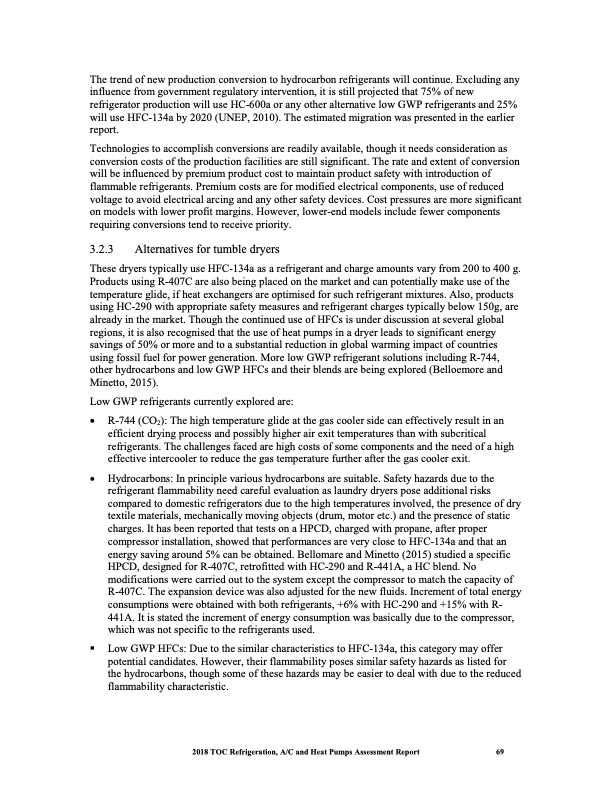
PDF Publication Title:
Text from PDF Page: 082
The trend of new production conversion to hydrocarbon refrigerants will continue. Excluding any influence from government regulatory intervention, it is still projected that 75% of new refrigerator production will use HC-600a or any other alternative low GWP refrigerants and 25% will use HFC-134a by 2020 (UNEP, 2010). The estimated migration was presented in the earlier report. Technologies to accomplish conversions are readily available, though it needs consideration as conversion costs of the production facilities are still significant. The rate and extent of conversion will be influenced by premium product cost to maintain product safety with introduction of flammable refrigerants. Premium costs are for modified electrical components, use of reduced voltage to avoid electrical arcing and any other safety devices. Cost pressures are more significant on models with lower profit margins. However, lower-end models include fewer components requiring conversions tend to receive priority. 3.2.3 Alternatives for tumble dryers These dryers typically use HFC-134a as a refrigerant and charge amounts vary from 200 to 400 g. Products using R-407C are also being placed on the market and can potentially make use of the temperature glide, if heat exchangers are optimised for such refrigerant mixtures. Also, products using HC-290 with appropriate safety measures and refrigerant charges typically below 150g, are already in the market. Though the continued use of HFCs is under discussion at several global regions, it is also recognised that the use of heat pumps in a dryer leads to significant energy savings of 50% or more and to a substantial reduction in global warming impact of countries using fossil fuel for power generation. More low GWP refrigerant solutions including R-744, other hydrocarbons and low GWP HFCs and their blends are being explored (Belloemore and Minetto, 2015). Low GWP refrigerants currently explored are: • R-744 (CO2): The high temperature glide at the gas cooler side can effectively result in an efficient drying process and possibly higher air exit temperatures than with subcritical refrigerants. The challenges faced are high costs of some components and the need of a high effective intercooler to reduce the gas temperature further after the gas cooler exit. • Hydrocarbons: In principle various hydrocarbons are suitable. Safety hazards due to the refrigerant flammability need careful evaluation as laundry dryers pose additional risks compared to domestic refrigerators due to the high temperatures involved, the presence of dry textile materials, mechanically moving objects (drum, motor etc.) and the presence of static charges. It has been reported that tests on a HPCD, charged with propane, after proper compressor installation, showed that performances are very close to HFC-134a and that an energy saving around 5% can be obtained. Bellomare and Minetto (2015) studied a specific HPCD, designed for R-407C, retrofitted with HC-290 and R-441A, a HC blend. No modifications were carried out to the system except the compressor to match the capacity of R-407C. The expansion device was also adjusted for the new fluids. Increment of total energy consumptions were obtained with both refrigerants, +6% with HC-290 and +15% with R- 441A. It is stated the increment of energy consumption was basically due to the compressor, which was not specific to the refrigerants used. Low GWP HFCs: Due to the similar characteristics to HFC-134a, this category may offer potential candidates. However, their flammability poses similar safety hazards as listed for the hydrocarbons, though some of these hazards may be easier to deal with due to the reduced flammability characteristic. 2018 TOC Refrigeration, A/C and Heat Pumps Assessment Report 69PDF Image | Heat Pumps Technical Options

PDF Search Title:
Heat Pumps Technical OptionsOriginal File Name Searched:
RTOC-assessment-report-2018_0.pdfDIY PDF Search: Google It | Yahoo | Bing
CO2 Organic Rankine Cycle Experimenter Platform The supercritical CO2 phase change system is both a heat pump and organic rankine cycle which can be used for those purposes and as a supercritical extractor for advanced subcritical and supercritical extraction technology. Uses include producing nanoparticles, precious metal CO2 extraction, lithium battery recycling, and other applications... More Info
Heat Pumps CO2 ORC Heat Pump System Platform More Info
| CONTACT TEL: 608-238-6001 Email: greg@infinityturbine.com | RSS | AMP |